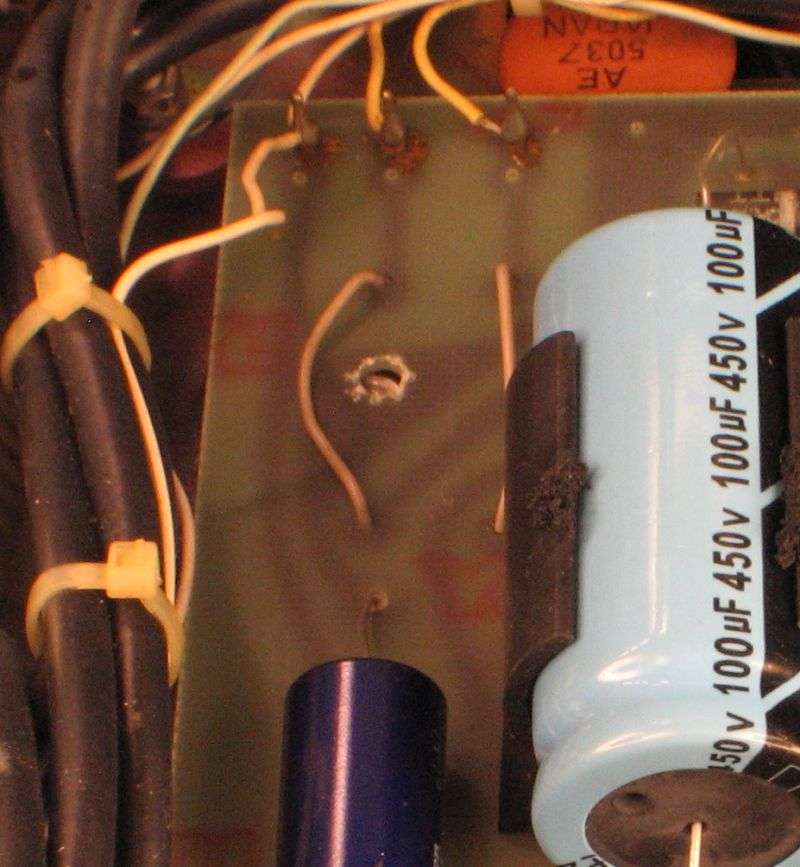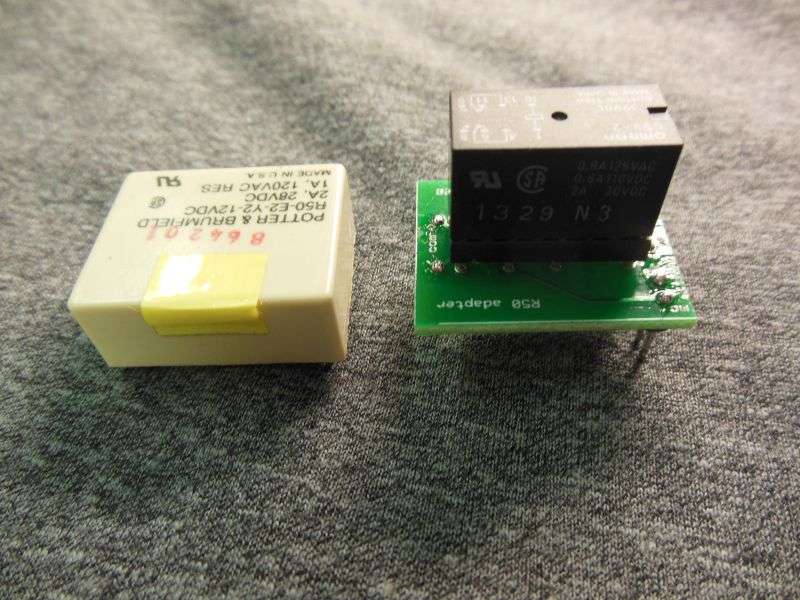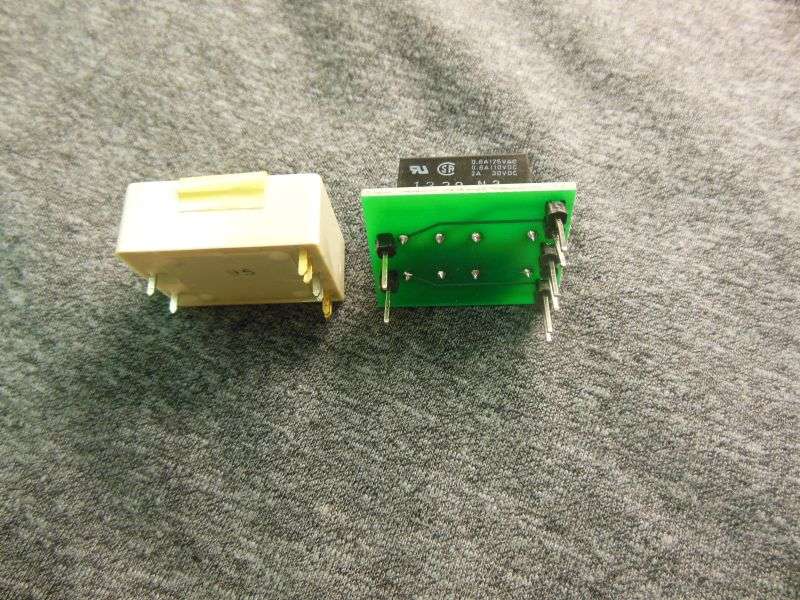You are using an out of date browser. It may not display this or other websites correctly.
You should upgrade or use an alternative browser.
You should upgrade or use an alternative browser.
-
You can now help support WorldwideDX when you shop on Amazon at no additional cost to you! Simply follow this Shop on Amazon link first and a portion of any purchase is sent to WorldwideDX to help with site costs.
Palomar 300a transformer
- Thread starter Staybolt
- Start date
Yep.
Two different transformers. Both look identical. No markings to hint which one it is.
The RF deck has a circuit board at the center of the chassis underside. Has two large filter capacitors on it, and one small electrolytic cap.
At the rear corner of this board opposite the large filters you find one of two types of HV rectifier.
If it has a single rectangular black-epoxy block. This is a bridge rectifier. The transformer that matches this amplifier delivered about 560 Volts AC to the HV circuit board.
If it has four black cylindrical-shaped rectifier diodes side-by-side, this RF deck was made to work the the lower-voltage version of the transformer, delivering about 280 Volts AC to the HV circuit board.
If you "just try" a mystery transformer there are two possible wrong combinations. The higher-voltage transformer will damage the RF deck built for the lower-voltage version.
A lower-voltage transformer won't damage the RF deck built for the higher-voltage transformer, but you'll have a 300A that is perpetually stuck on "Low" side, no matter which way you throw the High/Low switch.
Kinda like "Edison Roullette".
73
Two different transformers. Both look identical. No markings to hint which one it is.
The RF deck has a circuit board at the center of the chassis underside. Has two large filter capacitors on it, and one small electrolytic cap.
At the rear corner of this board opposite the large filters you find one of two types of HV rectifier.
If it has a single rectangular black-epoxy block. This is a bridge rectifier. The transformer that matches this amplifier delivered about 560 Volts AC to the HV circuit board.
If it has four black cylindrical-shaped rectifier diodes side-by-side, this RF deck was made to work the the lower-voltage version of the transformer, delivering about 280 Volts AC to the HV circuit board.
If you "just try" a mystery transformer there are two possible wrong combinations. The higher-voltage transformer will damage the RF deck built for the lower-voltage version.
A lower-voltage transformer won't damage the RF deck built for the higher-voltage transformer, but you'll have a 300A that is perpetually stuck on "Low" side, no matter which way you throw the High/Low switch.
Kinda like "Edison Roullette".
73
not what he said...So there is no way of knowing which one will work??? Oh thats just great........
If it has a single rectangular black-epoxy block. This is a bridge rectifier. The transformer that matches this amplifier delivered about 560 Volts AC to the HV circuit board.
If it has four black cylindrical-shaped rectifier diodes side-by-side, this RF deck was made to work the the lower-voltage version of the transformer, delivering about 280 Volts AC to the HV circuit board.
so...
So there is no way of knowing which one will work???
Shoulda said no EASY way.
Safest way is to take a 12-Volt AC transformer and feed it into the amplifier's power cord. Turn on the amplifier's power switch with the mystery transformer plugged into it.
The output voltage from the HV winding of the transformer will be safe to measure with the AC-Volts scale of any multimeter.

The three wires at the top-left corner of the HV board are first on the far left, the 12-Volt AC supply on the outermost pin.
The two wires to the right of it are the HV winding. If you measure about 28 Volts AC across those two wires, you have the lower-voltage transformer. If you have over 50 Volts AC there, you have the transformer that's a match for the rectangular-block bridge rectifier.
It's possible to convert the RF deck to accept the transformer you have.
This way you can see which combination of each you have safely without risk of letting out that expensive smoke.
73
That amplifier has the full-wave voltage doubler for the HV supply. The four 3 Amp rectifiers are hiding under the rear-most ends of the two large filter caps.
Takes the lower-voltage version of the 300A transformer, about 280 Volts AC.
The three white-plastic 1000uf 25-Volt electrolytics have to go. They have 1974 date codes on them. If you power it up with those in it, they will fail and cause one or more kinds of grief.
Likewise the two large 450-Volt filters are nearly as old. Only one has the date code visible, 1976.
Those parts aren't meant to last more than ten or fifteen years let alone 40-plus.
Do yourself a favor and replace them all before they go bad and cause real trouble.
That is, once you find a transformer.
Gives me an idea. This is one thing that a Palomar 350Z might actually be good for, as an organ donor.
The power transformer from a 350Z should be a good match for this RF deck. Just have to put it in a box with an appropriate cable and Jones plug to match the socket on the rear of the RF deck.
Finally! A practical use for a Palomar 350Z.
One more thought. The rusty screws holding down the rear corners of the circuit boards have to go. Replace them with new ones. They provide the ground connection for the circuit boards. But only if they are still made of metal. Rust is not so effective as a ground circuit.
73
Takes the lower-voltage version of the 300A transformer, about 280 Volts AC.
The three white-plastic 1000uf 25-Volt electrolytics have to go. They have 1974 date codes on them. If you power it up with those in it, they will fail and cause one or more kinds of grief.
Likewise the two large 450-Volt filters are nearly as old. Only one has the date code visible, 1976.
Those parts aren't meant to last more than ten or fifteen years let alone 40-plus.
Do yourself a favor and replace them all before they go bad and cause real trouble.
That is, once you find a transformer.
Gives me an idea. This is one thing that a Palomar 350Z might actually be good for, as an organ donor.
The power transformer from a 350Z should be a good match for this RF deck. Just have to put it in a box with an appropriate cable and Jones plug to match the socket on the rear of the RF deck.
Finally! A practical use for a Palomar 350Z.
One more thought. The rusty screws holding down the rear corners of the circuit boards have to go. Replace them with new ones. They provide the ground connection for the circuit boards. But only if they are still made of metal. Rust is not so effective as a ground circuit.
73
Yes i know the caps are old and they will go bye bye when i get the chance. Ok on it taking the lower voltage transformer . Ill tell my tech who has several what it takes.. i just hope he knows the diff as i have had to correct him on a few things in the past... hes not old, just forgets shit....
Good plan on the 350Z!
Staybolt,
I am in mid-restoration on a 300a at the moment. It is the same chassis as yours-with the separate rectifiers rather than the single block rectifier.
Per Nomad and Shockwave's "hints" I am adding ground braid to the circuit boards in my unit. The relay board, low voltage rectifier and high voltage rectifier boards have metal stand-offs on the chassis but they are getting the ground braid anyway.
Below is a picture of the relay board with the ground braid added. It may be hard to see as it is tucked in below the load capacitor. I made the braid from stripping out the RG-58U Foam coax I removed from my unit to replace it with some Teflon RG-313.

Below is the refreshed low voltage and high voltage boards.

Good Luck!
73's
David
Staybolt,
I am in mid-restoration on a 300a at the moment. It is the same chassis as yours-with the separate rectifiers rather than the single block rectifier.
Per Nomad and Shockwave's "hints" I am adding ground braid to the circuit boards in my unit. The relay board, low voltage rectifier and high voltage rectifier boards have metal stand-offs on the chassis but they are getting the ground braid anyway.
Below is a picture of the relay board with the ground braid added. It may be hard to see as it is tucked in below the load capacitor. I made the braid from stripping out the RG-58U Foam coax I removed from my unit to replace it with some Teflon RG-313.
Below is the refreshed low voltage and high voltage boards.
Good Luck!
73's
David
Only old-production tubes are short. Later-production GE tubes are also too tall.,
When factories were buying tubes a hundred thousand a year the incentive was to minimize material costs. A shorter tube uses less glass.
As the factories quit making televisions that used the 6KD6 the demand fell off. Production-run quantities of that type fell from thousand to hundreds. Now the labor expense of retooling the production line from short tubes to tall tubes outstripped the money saved on glass. As a result, all similar sweep tubes on the production schedule were built the same tall height. Labor to reload different-height glass was eliminated, and the higher cost of glass used was small in comparison. GE tubes from the 1980s are also too to tall.
When the 300A was designed, the factories were shipping mass quantities of the 6KD6 and 6LF6 to the TV factories. The 300A was designed for the tubes being made in the early to mid-1970s, the heyday of TVs that used those tubes. Nobody at Palomar had any idea that the tubes would get taller in ten years.
But by then the Palomar factory in Escondido was history, anyway.
The GE name alone on a tube won't guarantee that it's short enough.
FInding short tubes will require turning over a lot of rocks to look underneath for them. Raising the roof a bit may prove more practical.
Oh, and if you find the square plastic R50 relays are bad, you might need one or two of these.


The original R50 relay tends to be expensive when you can find it.
These are on Ebay.
73
When factories were buying tubes a hundred thousand a year the incentive was to minimize material costs. A shorter tube uses less glass.
As the factories quit making televisions that used the 6KD6 the demand fell off. Production-run quantities of that type fell from thousand to hundreds. Now the labor expense of retooling the production line from short tubes to tall tubes outstripped the money saved on glass. As a result, all similar sweep tubes on the production schedule were built the same tall height. Labor to reload different-height glass was eliminated, and the higher cost of glass used was small in comparison. GE tubes from the 1980s are also too to tall.
When the 300A was designed, the factories were shipping mass quantities of the 6KD6 and 6LF6 to the TV factories. The 300A was designed for the tubes being made in the early to mid-1970s, the heyday of TVs that used those tubes. Nobody at Palomar had any idea that the tubes would get taller in ten years.
But by then the Palomar factory in Escondido was history, anyway.
The GE name alone on a tube won't guarantee that it's short enough.
FInding short tubes will require turning over a lot of rocks to look underneath for them. Raising the roof a bit may prove more practical.
Oh, and if you find the square plastic R50 relays are bad, you might need one or two of these.


The original R50 relay tends to be expensive when you can find it.
These are on Ebay.
73
dxChat
- No one is chatting at the moment.
-
@ Wildcat27:Hello I have a old school 2950 receives great on all modes and transmits great on AM but no transmit on SSB. Does anyone have any idea?
-
-
-
dxBot:63Sprint has left the room.
-
dxBot:kennyjames 0151 has left the room.

